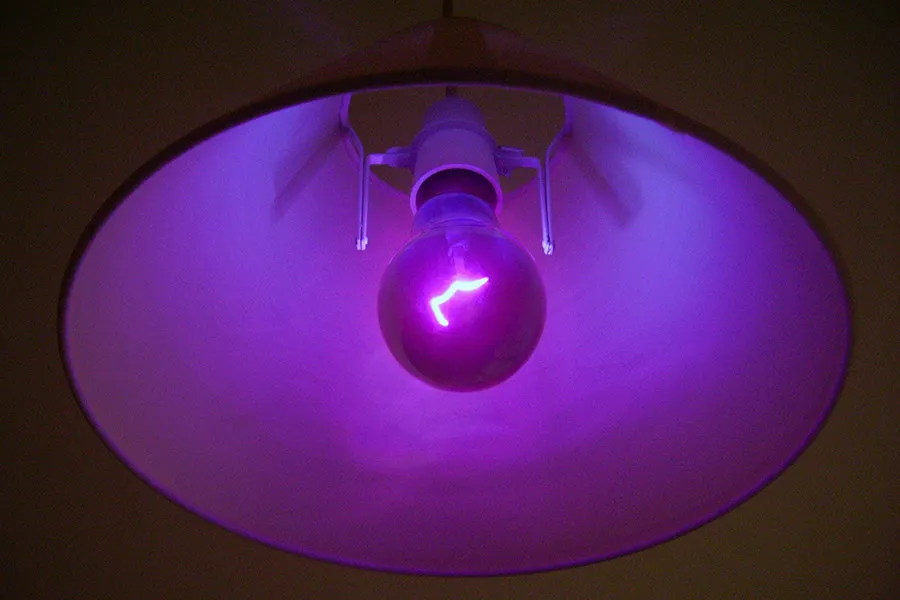Ultraviolet (UV) Radiation

Blacklights such as this emit invisible ultraviolet (UV) "light" as well as the purple light that you can see.
Public domain from Wikimedia Commons
Ultraviolet (UV) "light" is a type of electromagnetic radiation. UV light has a shorter wavelength than visible light. Purple and violet light have shorter wavelengths than other colors of light, and ultraviolet has even shorter waves than violet does; so ultraviolet is sort of "purpler-than-purple" light or "beyond violet" light.
Ultraviolet radiation lies between visible light and X-rays along the electromagnetic spectrum. UV "light" spans a range of wavelengths between about 10 and 400 nanometers. The wavelength of violet light is around 400 nanometers (or 4,000 Å). Ultraviolet radiation oscillates at rates between about 800 terahertz (THz or 1012 hertz) and 30,000 THz.
When we talk about visible light, we refer to the different wavelengths of light across the visible spectrum by the names of colors. Red light has a wavelength near 650 nm, while the wavelength of blue light is around 440 nm. The UV portion of the spectrum has different regions, like the different colors of visible light, that correspond to specific wavelengths of UV radiation.
Regions of the UV spectrum
Scientists subdivide the ultraviolet spectrum into regions named near UV, far UV, and extreme UV. These divisions are comparable to the partitions between different colors, and hence different wavelengths, of visible light. The near UV region lies closest to visible light, and includes wavelengths between 200 and 400 nm. The higher energy, shorter wavelength far UV region spans wavelengths between 91 and 200 nm. Extreme UV radiation has the shortest wavelength range and highest energies of the regions of the ultraviolet spectrum, and lies on the border between UV and X-ray radiation. Extreme UV radiation spans the 10 to 30 nm wavelength range. Normal air is largely opaque to UV with wavelengths shorter than 200 nm; oxygen absorbs "light" in that part of the UV spectrum. That is good news for us Earthlings, since our atmosphere shields us from the most dangerous, highest energy portions of the UV spectrum that reach our planet from the Sun and other sources in space.
When discussing the impact of UV radiation on the environment and human health, scientists subdivide the ultraviolet spectrum in a different way. They speak of the UV-A, UV-B, and UV-C regions of the UV spectrum. You have probably seen UV-A and UV-B mentioned on the labels for sunglasses or sunscreen. UV-A, which is also called "blacklight" or "Long Wave" UV, spans wavelengths between 320 and 400 nm. It is the closest UV radiation to visible light. Almost all of the ultraviolet radiation that makes it through our atmosphere to Earth's surface is UV-A. UV-B waves, with wavelengths between 280 and 320 nm, carry more energy than UV-A waves. UV-B radiation is the main cause of sunburn; the SPF factor listed on sunscreens refers to their ability to reduce the effects of UV-B. The third region of the UV spectrum, UV-C, includes radiation with wavelengths between 100 and 280 nm. These short-wavelength UV photons have high energies, and are very damaging to living creatures. UV-C is sometimes called "Short Wave" UV or "germicidal" UV; the latter because it is sometimes used to sterilize laboratory equipment or to purify water by killing microbes.
UV Radiation in Earth's Atmosphere
Earth's atmosphere prevents most UV radiation from space from reaching the ground. UV-C is entirely screened out by stratospheric ozone at around 35 km altitude. Most UV-A does reach the surface, but UV-A does little genetic damage to tissues. UV-B is largely responsible for sunburn and skin cancer, though it is mostly absorbed by ozone before reaching the surface. Levels of UV-B radiation at the surface are especially sensitive to the amount of ozone in the stratosphere.
© 2017 UCAR